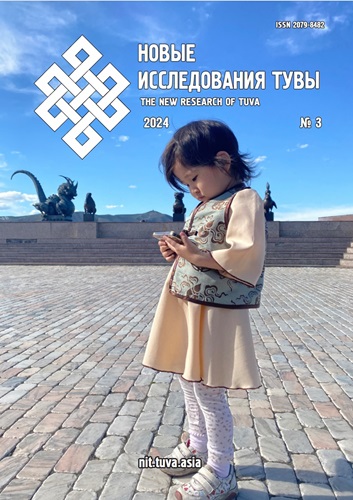Sacred toponyms of Tuva: lexical and semantic groups
DOI:
https://doi.org/10.25178/nit.2024.3.11Keywords:
onomastic; toponymic; sacred; holyness; Tuva; Tuvan people; Tuvan languageAbstract
The article analyzes the names of sacred toponyms in Tuva, which are places or natural objects revered by the Tuvan people as having special power. Some of these names directly contain terms related to holiness, while others do not, but they do contain other terms that indirectly indicate a sense of sacredness.
The research was based on the geographical names of certain sacred toponyms, as well as information gathered from residents of the area through scientific expeditions in the Republic of Tuva. The author also drew on personal memories from the older generation of their family, who were native to the village of Don-Teresin in the Barun-Khemchik district. When analyzing the names, several lexical and semantic groups were considered: names of sacred springs, rivers, lakes, names of sacred passes and hills, names of religious camps, and names of forest areas. Examples were given for each group, along with explanations from residents and descriptions of the characteristics of these places.
References
Adygbai, Ch. O. and Kongu, A. A. (2016) Sacred aspects of Buddhist monasteries of Tuva. Vestnik Kalmytskogo universiteta, no. 3 (31), pp. 4–12. (In Russ.).
Aiyzhy, E. V. and Bazyrchap, A.-Kh. O. (2014) Sacred sites of the Tsaatans in the somon of Tsagaannuur of the Khubsugul aimag of Mongolia. Vestnik Kalmytskogo instituta gumanitarnykh issledovanii RAN, no. 1, pp. 31–35. (In Russ.).
Kara-ool, L. S. (2018) Lexical features of microtoponyms of Ovyur rayon of Tuva. New Research of Tuva, no. 3, pp. 162–189. (In Russ.). DOI: https://doi.org/10.25178/nit.2018.3.11
Kara-ool, L. S. (2019) Lexics of maternal rites in toponyms of Tuva. Mir nauki, kul'tury, obrazovaniia, issue 3 (76), pp. 368–369. (In Russ.).
Kara-ool, L. S. (2020) Animal-related names in tuvinian toponymy. Mir nauki, kul'tury, obrazovaniia, no. 5 (84), pp. 280–284. (In Russ.). DOI: https://doi.org/10.24411/1991-5497-2020-00961
Kara-ool, L. S. (2021) Confessional Vocabulary in the Toponyms of Tuva. New Research of Tuva, no. 2, pp. 52–66. (In Russ.). DOI: https://doi.org/10.25178/nit.2021.2.5
Kopeliovich, G. B. (2018) Arzhaans as part of the cultural and religious landscape of the Republic of Tuva. New Research of Tuva, no. 4, pp. 112–124. (In Russ.). DOI: https://doi.org/10.25178/nit.2018.4.6
Lamazhaa, Ch. K., Sanchai, Ch. Kh. and Mongush, A. V. (2023) Ritual ribbons and flags in the practical activities of contemporary Tuvans. New Research of Tuva, no. 4, pp. 344–370. (In Russ.). DOI: https://doi.org/10.25178/nit.2023.4.24
Lamazhaa, Ch. K., Suvandii, N. D. and Mongush, A. V. (2023) The Sacred in Tuvan Culture: Past and Modernity. New Research of Tuva, no. 3, pp. 220–241. (In Russ.). DOI: https://doi.org/10.25178/nit.2023.3.14
Lamazhaa, Ch. K. and Shaimerdenova, M. Dzh. (2024) Kadak is a scarf of offering and consecration (from the history of tradition). New Research of Tuva, no. 2, pp. 152–176. (In Russ.). DOI: https://doi.org/10.25178/nit.2024.2.10
Mongush, M. V. and Mongush, E. D. (2015) Places of worship in the cultural landscapes of Buryatia and Tuva. New Research of Tuva, no. 2, pp. 48–60. (In Russ.).
Ondar, B. K. (2004) Toponymic Dictionary of Tuva. Abakan, Khakass State University Press. 256 p. (In Russ.).
Ondar, B. K. (2007) Toponymic Dictionary of Tuva. 2nd ed. Kyzyl, Tuvan Book Publishing House. 550 p. (In Russ.).
Ondar, B, K. (2008) Tuvan toponymy. Comparative analysis of the toponymy of Tuva with the toponyms of Southern Siberia and other Turkic-speaking territories. Kyzyl, Tuvan Book Publishing House. 296 p. (In Russ.).
Ondar, B. K. (2011) Russian toponymy of Tuva. Kyzyl, Editorial and Publishing Department of TuvSU. 168 p. (In Russ.).
Oorzhak, V. O. (2018) The Extraction of Chonar-Dash: traditional technology and a part of Tuvan environmental culture. New Research of Tuva, no. 4, pp. 210–234. (In Russ.). DOI: https://doi.org/10.25178/nit.2018.4.12
Semenov, A. V. (2010) Tuva Mountain Sanctuaries. Vestnik Sankt-Peterburgskogo gosudarstvennogo universiteta, no. 2, issue 4, pp. 140–146. (In Russ.).
Suvandii, N. D. and Kara-ool, L. S. (2020) Dictionary of Itinerant Onomastics of the Tuvan language. Kyzyl, Editorial and Publishing Department of TuvSU. 64 p. (In Russ.).
Tatarintsev, B. I. (1973) About the peculiarities of the toponymy of Northeastern Tuva. In: The origin of the aborigines of Siberia and their languages: mat. the All-Union. Conf. June 14–16, 1973 / editorial board: E. G. Bekker et al. Tomsk, Publishing house of Tomsk University. 235 p. Pp. 142–144. (In Russ.).
Tatarintsev, B. I. (1977) About the toponymy of the Kaa-Khem River basin. In: Tuvan language and literature in the post-October period / ed. by D. A. Mongush. Kyzyl, Printing house of the Department for Publishing, Printing and Book Trade of the Council of Ministers of the Tuvan ASSR. 192 p. Pp. 88–98. (In Russ.).
Tuva. Native land (2023) / ed. by Ch. K. Lamazhaa and N. D. Suvandii. St. Petersburg, Nestor-Istoriia. 344 p. (In Russ.).
Published
How to Cite
For citation:
Suvandii N. D. Sacred toponyms of Tuva: lexical and semantic groups. New Research of Tuva, 2024, no. 3, pp. 191-202 (In Russ.). DOI: https://doi.org/10.25178/nit.2024.3.11
Issue
Section

This work is licensed under a Creative Commons Attribution-NonCommercial 4.0 International License.

Author(s) license holder(s) grant rights for their work to the journal (grantee of a license) under the simple non-exclusive open license in accordance with Art. 1286.1 «Open license for a research work, work of literature or fine arts», Civil Code of the Russian Federation.
New Research of Tuva publishes articles under the Creative Commons Attribution-NonCommercial license (CC BY-NC).
Since it is an open license, author(s) reserve the right to upload the article to their institutional repository, submit it to another journal (if it allows republications), or republish it on their own website (in full, or in part).
However, several conditions apply here:
a) The republished version must always contain the name(s) and affiliation(s) of the author(s), the original title and the hyperlink to the original version on the New Research of Tuva website;
b) It must be in open access, free of charge, and no category of readers must be in any way whatsoever advantaged over general readership.
c) should the contribution be submitted elsewhere by its author(s) without substantial modification (30% or more of original text unchanged), the body of the article should contain a disclaimer that the original version was published in New Research of Tuva (with a link to the respective page)
The CC-BY-NC is a non-revocable license which applies worldwide and lasts for the duration of the work’s copyright.









